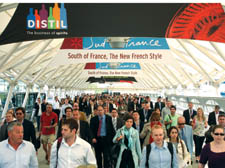
The London International Wine Festival in Docklands is Britain’s largest wine event |
Review | Food and Drink | The Wine Press | Excel Centre| London International Wine Fair LIWF | Docklands | Vin de Pays | Anglo-American |French
The contest to select the Top 100 Vin de Pays put a little soul into the three-day London International Wine Fair
THE competition to find France’s top 100 Vins de Pays (VDP) is one of the most popular events at the London International Wine Fair (LIWF).
The LIWF, the largest event of its kind in Britain, is held each May at the ExCel Centre in Docklands.
With around 1,100 exhibitors and an absolute minimum of 15,000 wines to taste, it’s representative of what is still the most competitive market for wine in the world.
But size guarantees neither quality nor interest! The event is not about the intrinsic value of your wines, it’s about marketing on an Anglo-American model that has little room for minnows.
Even so, it’s not the well-known brands and larger commercial interests that give the three-day trade show life and meaning, but those at the margins struggling – and all too often failing – to attract the attention they deserve.
With the odds stacked against them, it makes little sense for a small French, Italian, Spanish or Eastern European winemaker to make the effort to come to London.
The VDP competition, now in its fifth year, has succeeded in giving the London fair something we might – just – be able to recognise as a soul! It can claim to give prominence to small producers and has given a platform for French wines to fight back against the New World.
In the 10 years from 1996, New World wines tripled the volume of their exports worldwide. The effects of this were felt throughout the French wine industry, but especially in the south with the heaviest proportion of small producers.
By concentrating on VDP production, the competition offers a lifeline to those who most need it. 2007 attracted 1,115 entries, increasing to 1,214 in 2008.
Reducing this list to 100 with the aid of 19 judges, led by Observer wine correspondent Tim Atkin, not only qualifies as one of the 12 labours of Hercules, but is necessarily an imperfect process. One in 12 bottles was chosen in 2008. There is, in these circumstances, a strong suspicion of bias in favour of fruit-led New World styles at the expense of the more traditional wines with a wider and subtler range of tastes for which France is rightly renowned.
VDP as an official category of wine is largely confined to southern France. It denotes the separate nature of wine production in the south of France from the “official” network of Appellation d’Origine Contrôlée (AOC) authentication and control. The compatibility between AOC and VDP systems remains an open question. But, in practice, many small producers in the south divide their crop between AOC and VDP, in the hope of making more money on the former but using the latter to experiment or make the sort of wines they themselves prefer.
Back at the ExCel Centre, the 100 VDP competition offers a wide range of reasonably priced French wines, generally from small producers, at a time when prices are rising.
The lesson is that France’s national interest is better served by promoting these wines than by backing bigger names or throwing their poorer wines at discounted prices into the British supermarkets.
France remains the producer of the world’s most diverse range of wines.
Big names are interested in the VDP competition – Marks and Spencer with the best white in 2008 (2007 Grenache Blanc at £5.49) and Majestic with the best Syrah (Château Complazens, same year, at £1 more). But most of the exhibitors were small and medium sized.
Fifty-five per cent of the wines entered (671 out of 1,214) came from the single region of Languedoc. But the much smaller south-west region, adjacent to Languedoc, entered 95 wines, a larger entry in proportion to its production. This is from an area specialising in indigenous grapes, driving home the lesson that small producers exploiting the benefits of local grape varieties are the best guarantors of the future of affordable French wine.
The London International Wine Fair 2008 ExCel Centre, May 20-22
The Trophy Wines: the best of the Best 100 French Vins de Pays wines, as decided by an English judging panel:
White Trophy Wines:
* Viognier Trophy. Also judged the Best White
Laurent Miquel, Viognier Nord Sud, 2003, Vin de Pays d'Oc. available from M&S
* Chardonnay Trophy
Domaine de Corneille, Le Cite de Foncalieu Grand Reserve, Vin de Pays d'Oc
* Vermentio Trophy
Domaine des Lauriers, Vermentino, 2004, Vin de Pays d'Oc.
* Chardonnay Blend Trophy
Domaine Caillaubert, Chardonnay/Semillon, 2003, Vin de Pays des Cotes de Gascogne
* Sauvignon Blanc Trophy
French Connection, Sauvignon Blanc, Vignobles Du Peloux, 2004, Vin de Pays des Cotes de Gascogne.
* Other White Blends Trophy
Domaine de Pallehaut, 2004, Vin de Pays des Cotes de Gascogne.
Red Trophy Wines:
* Syrah Trophy. Also judged the Best Red Domaine
Camplazens, Syrah, 2004, Vin de Pays d'Oc. available from Majestic
* Pinot Noir Trophy
Vignoble Guillaume, Pinot Noir Vieilles Vignes, 2003, Vin de Pays de Franche Comte.
* Cabernet France Trophy
Baronnie de Bourgade, Les 3 Poules Cabernet Franc, 2004, Vin de Pays des Cotes de Thongue.
* Grenache Trophy
Maison Galhaud, Grenache 2004, Vin de Pays des Cotes Catalanes.
* Merlot Trophy
Domaine Paul Mas,Le Forge Estate Merlot, 2004, Vin de Pays d'Oc.
*Cabernet Sauvigon Trophy
Gerard Bertrand Collection, Cabernet Sauvignon, 2003, Vin de Pays d'Oc.
– For the full list of 100 Vins de Pays go to:
http://www.sopexa.co.uk/files/news/1209055078.pdf
|









